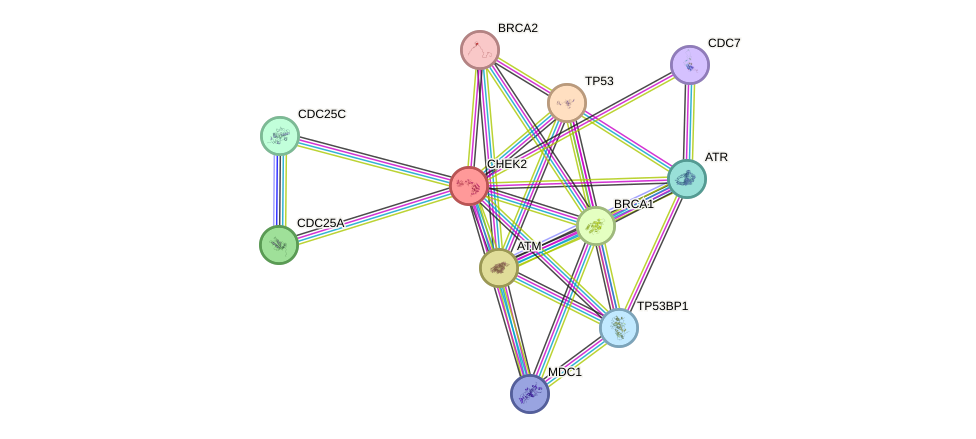GenAge entry for CHEK2 (Homo sapiens)
Gene name (HAGRID: 247)
- HGNC symbol
- CHEK2
- Aliases
- CDS1; CHK2; HuCds1; PP1425; bA444G7; RAD53
- Common name
- checkpoint kinase 2
Potential relevance to the human ageing process
- Main reason for selection
- Entry selected based on evidence linking the gene product to a pathway or mechanism linked to ageing
- Description
CHEK2 is a cell cycle checkpoint regulator and putative tumor suppressor. It blocks cell cycle progression in response to DNA damage.
Loss or haploid loss of CHEK2 enables mice lacking BRCA1 to avoid embryonic lethality and display signs of premature ageing at about 18 months of age and develop multiple tumours later in life. Absence of CHEK2 may have attenuated TP53-dependent apoptosis and growth arrest [1838]. Similarly, CHEK2 deletion partly rescues accelerated ageing and age-associated pathologies from both TERC and TRF1 mutant mice [3620].CHEK2 is also essential for eliminating mouse oocytes with unrepaired DNA damage [3619]. In humans, mutations in CHEK2 have been shown to confer susceptibility to multiple tumours and have been associated with Li-Fraumeni syndrome [1859].
Cytogenetic information
- Cytogenetic band
- 22q12.1
- Location
- 28,687,743 bp to 28,741,834 bp
- Orientation
- Minus strand
Protein information
- Gene Ontology
-
Process: GO:0000077; DNA damage checkpoint
GO:0000086; G2/M transition of mitotic cell cycle
GO:0001302; replicative cell aging
GO:0001934; positive regulation of protein phosphorylation
GO:0006302; double-strand break repair
GO:0006351; transcription, DNA-templated
GO:0006355; regulation of transcription, DNA-templated
GO:0006468; protein phosphorylation
GO:0006974; cellular response to DNA damage stimulus
GO:0006975; DNA damage induced protein phosphorylation
GO:0006977; DNA damage response, signal transduction by p53 class mediator resulting in cell cycle arrest
And 25 more GO terms Cellular component: GO:0000781; chromosome, telomeric region
GO:0005654; nucleoplasm
GO:0005794; Golgi apparatus
GO:0016605; PML body
Show all GO termsFunction: GO:0004674; protein serine/threonine kinase activity
GO:0005515; protein binding
GO:0005524; ATP binding
GO:0019901; protein kinase binding
GO:0031625; ubiquitin protein ligase binding
GO:0042802; identical protein binding
GO:0042803; protein homodimerization activity
GO:0046872; metal ion binding
Protein interactions and network
- Protein-protein interacting partners in GenAge
- TP53, ATM, FOS, BRCA1, VCP, BRCA2, PML, PRKDC, RB1, FOXM1, APP, SIRT1, MAPK3, MDM2, ATR, CHEK2, ARHGAP1, TP53BP1
- STRING interaction network
Retrieve sequences for CHEK2
Homologs in model organisms
- Caenorhabditis elegans
- CELE_T08D2.7
- Danio rerio
- chek2
- Drosophila melanogaster
- lok
- Mus musculus
- Chek2
- Rattus norvegicus
- Chek2
- Saccharomyces cerevisiae
- DUN1
- Schizosaccharomyces pombe
- cds1
In other databases
- GenAge model organism genes
- CellAge
- This gene is present as CHEK2
Selected references
External links
- EPD
- ORF Accession
- NM_001005735
- CDS Accession
- NP_001005735
- OMIM
- 604373
- HPRD
- 05084
- Ensembl
- CHEK2
- UniProt/Swiss-Prot
- CHK2_HUMAN
- GeneCards
- CHEK2
- Entrez Gene
- 11200
- UniGene
- 291363
- GenAtlas
- CHEK2
- Internet
- Search Google

